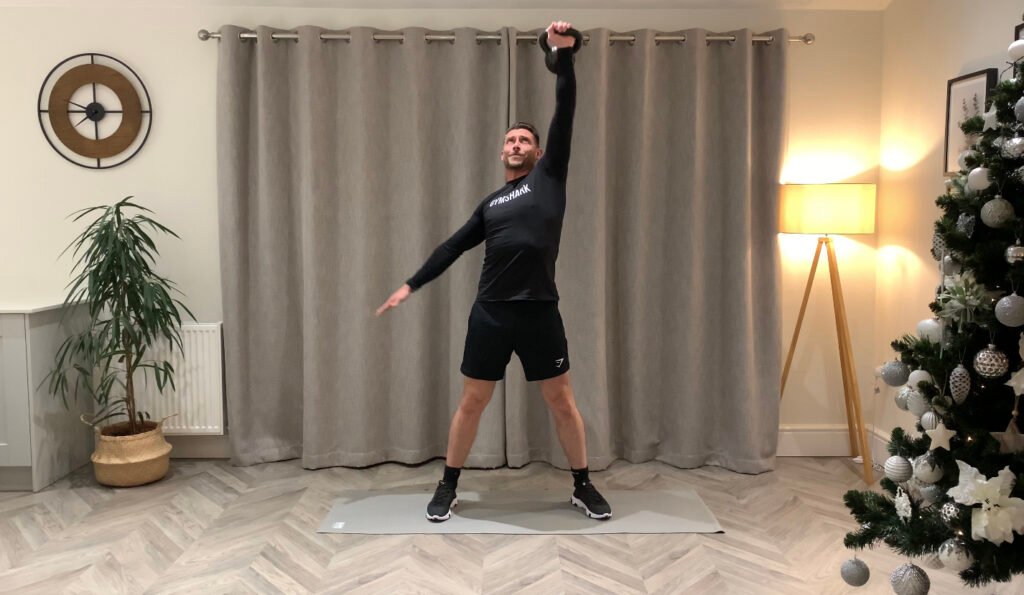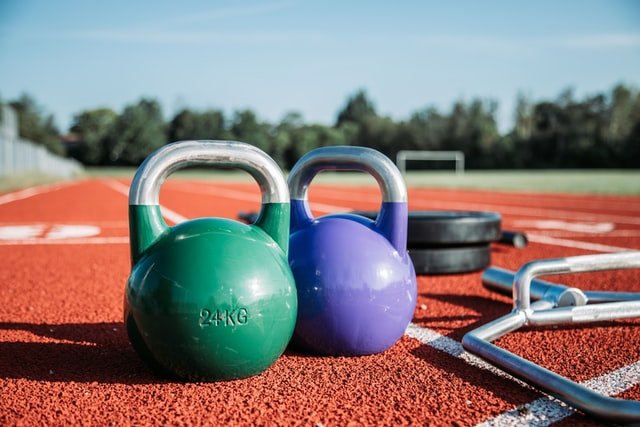Why Do Kettlebells Hurt My Hamstrings?
One of the most common problems people have when swinging a kettlebell is the aching/pain that is felt after a workout, compared to a regular workout.
This is because when you are using a kettlebell, at one time you can be using hundreds of muscles at once!
Which means if you are new to swinging them, you might be using more muscles than you normally would…
Hence the reason you are reading this now maybe?
Kettlebells can hurt your hamstrings for many reasons, so let’s take as to why this is.
Why Do Kettlebells Hurt My Hamstrings?
Kettlebells hurt your hamstrings for various reasons, one of them could be down to the fact you aren’t used to training with them. Maybe your form needs work and adjusting. As you know kettlebell exercises are a form of ballistic training which will increase your explosive power and thus use muscles that you aren’t used to using. Check at your foot position…are you bending your upper torso over too much or not at all and do you hinge from your hips? If your posture is spot on, it may have something to do with the volume of training you are doing, look to reduce to time you spend using the kettlebell to see if that helps the problem. The weight of the kettlebell used is also an important factor to consider. Just because you are used to training with other equipment at a certain weight, this doesn’t mean you are going to be able to use the same weight of KB. One thing that always gets overlooked is stretching. Are you stretching and warming up to a reasonable standard? If you have injured your hamstrings in the past, there’s a high chance of doing so again. Read on for more in depth information.
What Are Hamstrings and How Do You Injure them?
Hamstrings are tendons which are strong bands of tissue at the back of the thighs that attach the large thigh muscle to the bone.
The term “hamstring” also refers to the group of 3 muscles that run along the back of your thigh, from your hip to just below your knee.
The hamstring muscles are not used much when just standing or walking, but they’re used much more during activities that involve bending the knee, such as running, jumping and climbing.
An injury can often happen during sudden, powerful movements, such as sprinting, lunging or jumping that overstretch your tendons or muscles. The injury can also happen gradually during slower movements.
Mild hamstring strains (grade 1) will usually cause sudden pain and tenderness at the back of your thigh. It may be painful to move your leg, but the strength of the muscle should not be affected.
Partial hamstring tears (grade 2) are usually more painful and tender. There may also be some swelling and bruising at the back of your thigh and you may have lost some strength in your leg.
Severe hamstring tears (grade 3) will usually be very painful, tender, swollen and bruised, making it difficult to walk and stand. There may have been a “popping” or elastic band “twanging” sensation at the time of the injury and you’ll be unable to use the affected leg.

Recurring injury is common in athletes and sportsmen, as you’re more likely to injure your hamstring if you’ve injured it before.
Regular stretching and strengthening exercises and warming up before exercise, may help reduce the risk of injuring your hamstring.
So how does this relate to kettlebells? Let’s look at some reasons why this may be.
Form Guide
It goes without saying no matter what type of training you are doing, that the correct posture and form are crucial.
Kettlebells are no exception, they are maybe even more important than most pieces of equipment when it comes to posture.
If you are having problems with tight hamstrings or even having hamstring pain, there are multiple reasons why this is the case.
Let’s take a look at a regular kettlebell swing regarding how you should stand, pivot and swing etc.
Kettlebell swings work the posterior chain (which includes the hamstrings), so it is normal that they would be sore. Once your body gets used to doing them (around twice a week or more) you’ll find you don’t get as sore unless you increase the volume (more on this later).
Your bottom (glutes) may also get sore, because it is heavily involved when performing swings. A slight bit of soreness is ok, where as pain is another thing.
When you swing the kettlebell, you are exerting a large amount of force through the hips and body, after the kettlebell reaches its highest point (around shoulder height and parallel to the floor) it swings back down between your legs, then you pivot your hips and lean forward to cushion the kettlebell swing, then explode the hips forward and pull the kettlebell back from between your legs and repeat exercise.
If you are doing the swing correctly, you will feel a slight pull on the hamstrings, if you don’t it means they are pliable enough for you to not worry, or you might not be hinging enough with your hips and this means the lower part of your back is picking up the slack.
Over time you will get lower back pain, which may hinder your kettlebell progression. So consider hinging with your hips enough to feel a slight pull as the bell swings between your legs.
Anymore than a slight pull may indicate other postural issues.

Bend The Knee
Not bending knees and either locking or almost locking them will put extra strain on hamstrings.
Also, how much are you bending over when the kettlebell is swinging between your legs? This is another massive contributing factor on your hamstrings.
As if you are bending over too far (more than 45 degrees) it will pull even more on your hamstrings and lower back. As you are in affect doing an actual hamstring stretch but over the duration of the exercise or complete workout.
If you try standing straight and bending over, you will feel the pull on your hamstrings. Now add a swinging and potentially heavy weight to that lever mechanism.
That’s a lot of force on your poor hamstrings trying to fight against the laws of gravity!
Depending on how you position your feet, you can work one hamstring muscles more than others.
If you point your toes outward you will work the outside muscles more, whereas if you point forward the inside muscles will be activated. So you could actually choose which hamstring muscles to work.
Be conscious of your knee and foot position, plus how much you are hinging through your hips? These three adjustments alone can completely change how it feels to swing a kettlebell.
Its always good practice to check your form in the mirror.
One last thing on posture, for a kettlebell swing, you will need to generate a large amount of power to manage the weight.
If you don’t control it, it will control you… which will inevitably lead to injury.
I bet you never thought that a kettlebell swing could be so complicated right? The thing is, we’re all build differently and these tips are just pointers to try out to help you tweak your technique.
DOMS
Delayed onset muscle soreness (DOMS) is the pain and stiffness felt in muscles several hours to days after unaccustomed or strenuous exercise. The soreness is felt most strongly 24 to 72 hours after the exercise.
DOMS are perfectly normal. Delayed onset muscle soreness is just a sign that your body is adapting to a new stress, and the soreness should go away given time.
You may want to consider doing some stretching to gain more mobility in your hips (look up stretches for your hip adductors, hip abductors, hip flexors, glutes, hamstrings), but just keep swinging if it feels right for you to do so.

One thing I always remind peers is to listen to your body. What I mean by this is that, if you feel a problematic area, let’s say hamstrings for example.
Then if you have pain in that area, it’s heavily advised that you rest for the time being. Theres a huge difference between soreness and pain. If you are experiencing long periods of pain it is advised you seek medical advice ASAP to get the issue treated.
Kettlebell Weight and Volume?
If you have been working out with kettlebells for a while and you are having hamstring problems, have you changed anything to warrant the issue?
What I mean is, have you recently done anything different like increase the amount of time you are swinging the kettlebell? If training volume has been increased maybe consider reducing the amount of time you spend working out and slowly build back up the volume over time.
Another common reason people can have hamstring problems is because they have increased the weight of the kettlebell.

I have fallen victim to this in the past and it can be quite frustrating. Consider reducing the amount of time you train with the heavier kettlebell and incorporate the heavier kettlebell with your older lighter counterpart.
These two minor alterations kind of go hand in hand, so think about maybe reducing both if they apply to you.
Its also worth mentioning that the muscles around the hamstring could also be weak, which means the hamstrings are working harder to compensate to allow you to move as freely as you do.
Take time to work on your hip flexibility and look to strengthen them too. Look at working your glutes as well as you calves. anyone of these weakened muscles can severely cause damage to the muscles themselves or the muscles around them too.
Stretching Habits
It goes without saying that you should stretch and warm up before you participate in any exercise.
If you are getting on the kettlebells cold, there’s a high probability you will pull a muscle over time, especially if you are an older person or if you have had an injury in that area before.
Statistics show that if you have been injured in a certain place before, it’s highly likely that you will get injured in that same place again.
So always warm up before you exercise.
If you aren’t sure what type of stretching to do, you could try my 15 minute warm up routine I did a while back. It incorporates yoga sun salutation, as well as some yoga poses and general movement flow.
If you enjoyed this, then please check out the YouTube channel, with over 40 workouts which include the use of kettlebells, resistance bands, dumbbells and even body weight exercises too.
Don’t forget, I will be adding more workouts weekly to help you stay fit and healthy at home with just the use of a kettlebell.
With workouts of all types, for all fitness levels. You know that we have you covered, so stay tuned for more.
If you enjoy sport and use CBD to help with your recovery in between gruelling workouts, then your are in the right place. Here at Sport CBDs, we train hard and recover the best way possible…
We have regular workouts (check out the YouTube channel), CBD news and CBD products to help you gain that edge!
If you wanted to check out the reputable CBD we have on offer here at the site, then please head to the Sport CBDs Store. We also do fitness clothing and yoga accessories too.
Until next time, all the best…


